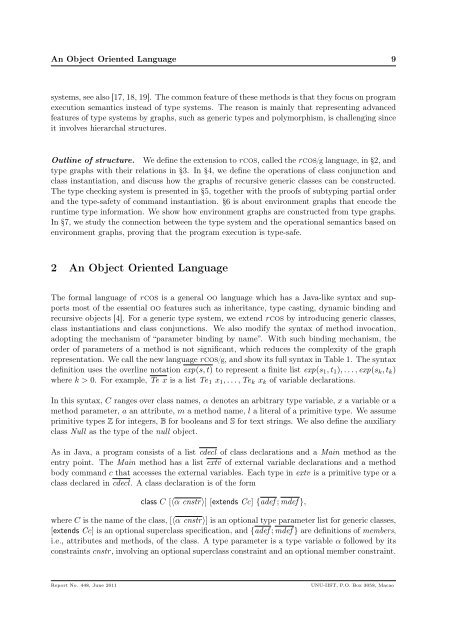A Graph-Based Generic Type System for Object-Oriented Programs
A Graph-Based Generic Type System for Object-Oriented Programs
A Graph-Based Generic Type System for Object-Oriented Programs
You also want an ePaper? Increase the reach of your titles
YUMPU automatically turns print PDFs into web optimized ePapers that Google loves.
An <strong>Object</strong> <strong>Oriented</strong> Language 9systems, see also [17, 18, 19]. The common feature of these methods is that they focus on programexecution semantics instead of type systems. The reason is mainly that representing advancedfeatures of type systems by graphs, such as generic types and polymorphism, is challenging sinceit involves hierarchal structures.Outline of structure. We define the extension to rcos, called the rcos/g language, in §2, andtype graphs with their relations in §3. In §4, we define the operations of class conjunction andclass instantiation, and discuss how the graphs of recursive generic classes can be constructed.The type checking system is presented in §5, together with the proofs of subtyping partial orderand the type-safety of command instantiation. §6 is about environment graphs that encode theruntime type in<strong>for</strong>mation. We show how environment graphs are constructed from type graphs.In §7, we study the connection between the type system and the operational semantics based onenvironment graphs, proving that the program execution is type-safe.2 An <strong>Object</strong> <strong>Oriented</strong> LanguageThe <strong>for</strong>mal language of rcos is a general oo language which has a Java-like syntax and supportsmost of the essential oo features such as inheritance, type casting, dynamic binding andrecursive objects [4]. For a generic type system, we extend rcos by introducing generic classes,class instantiations and class conjunctions. We also modify the syntax of method invocation,adopting the mechanism of “parameter binding by name”. With such binding mechanism, theorder of parameters of a method is not significant, which reduces the complexity of the graphrepresentation. We call the new language rcos/g, and show its full syntax in Table 1. The syntaxdefinition uses the overline notation exp(s, t) to represent a finite list exp(s 1 , t 1 ), . . . , exp(s k , t k )where k > 0. For example, Te x is a list Te 1 x 1 , . . . , Te k x k of variable declarations.In this syntax, C ranges over class names, α denotes an arbitrary type variable, x a variable or amethod parameter, a an attribute, m a method name, l a literal of a primitive type. We assumeprimitive types Z <strong>for</strong> integers, B <strong>for</strong> booleans and S <strong>for</strong> text strings. We also define the auxiliaryclass Null as the type of the null object.As in Java, a program consists of a list cdecl of class declarations and a Main method as theentry point. The Main method has a list extv of external variable declarations and a methodbody command c that accesses the external variables. Each type in extv is a primitive type or aclass declared in cdecl. A class declaration is of the <strong>for</strong>mclass C [〈α cnstr〉] [extends Cc] {adef ; mdef },where C is the name of the class, [〈α cnstr〉] is an optional type parameter list <strong>for</strong> generic classes,[extends Cc] is an optional superclass specification, and {adef ; mdef } are definitions of members,i.e., attributes and methods, of the class. A type parameter is a type variable α followed by itsconstraints cnstr, involving an optional superclass constraint and an optional member constraint.Report No. 448, June 2011UNU-IIST, P.O. Box 3058, Macao
















